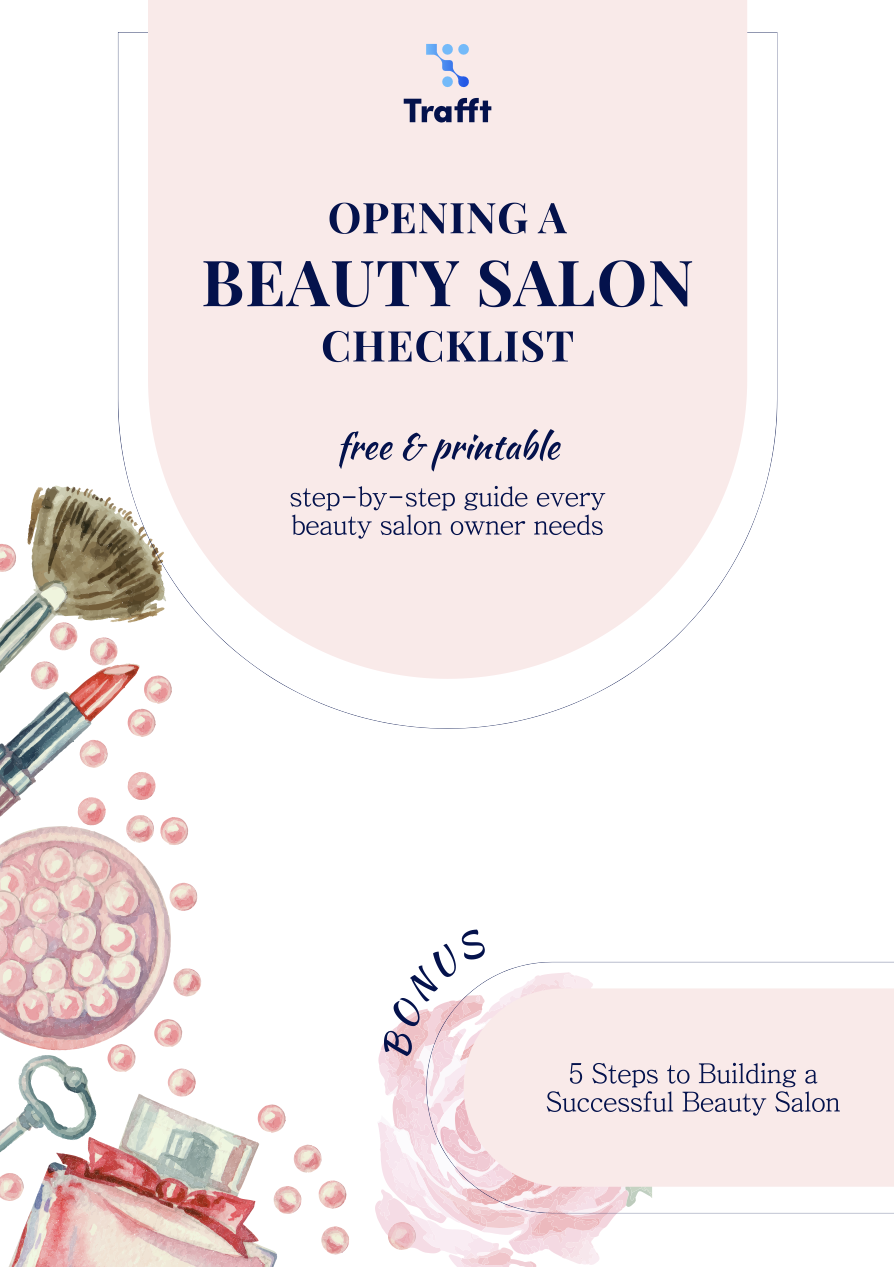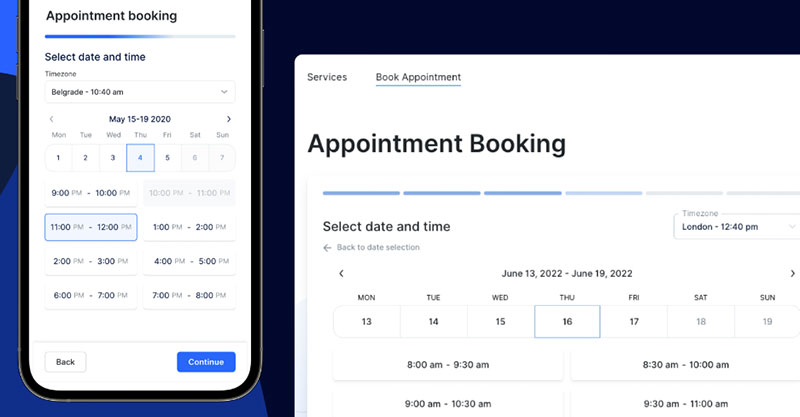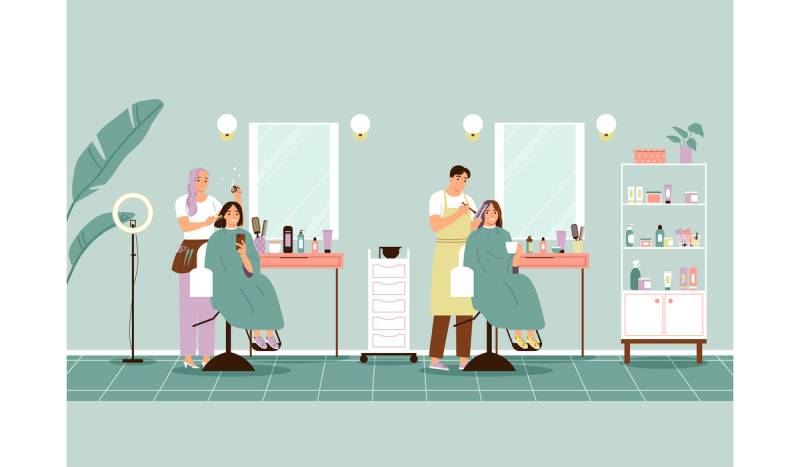The beauty industry is booming, and there's never been a better time to bring your creative vision to life and carve your niche in this fabulous world. Are you ready to embark on this thrilling journey yourself and learn how to open a beauty salon? Hold on tight, because opening a beauty salon isn't just about your love for all things beauty - it takes careful planning, smart decisions, and a whole lot of industry know-how.
This article is your ultimate guide to making your beauty salon dreams a reality. We'll take you through the crucial steps, insider tips, and must-know secrets to set you up for success. From getting crystal clear on your salon's vision to diving deep into market research, creating a killer business plan, securing that much-needed financing, and hiring a winning team, we've got your back every step of the way.
So, if you're ready to turn your beauty dreams into a reality, grab your favorite lipstick, channel your inner entrepreneur, and let's dive headfirst into the dazzling world of opening a beauty salon together!
How to Open a Beauty Salon in 11 Easy Steps:
Thank you for subscribing. Check your mail for details
- Put Your Ideas into Practice
- Analyze the Rivals
- Craft Your Beauty Salon Business Plan
- Research Beauty Industry Regulations
- Get the Right Insurance
- Find the Right Location
- Factor in the Costs of Opening a Beauty Salon
- Think About the Profit
- Embrace Innovative Technology
- Hire and Train Staff
- Get Your Beauty Salon Out There
Put Your Ideas into Practice
Before diving into the glamorous world of beauty, it's time to envision the kind of salon you want to run! There's a whole galaxy of possibilities out there, so let your imagination run wild.
Do you want to create a haven for trendsetting fashionistas? Or perhaps you're dreaming of a cozy retreat where busy moms can relax and unwind. Maybe you're even considering a salon that specializes in out-of-this-world nail art. Answering these questions should be the very first step on your opening a salon checklist.
Some of the services you might offer are:
- Hair treatments, like bleaching, waxing, laser hair removal, or electrolysis
- Specialist hair treatments, such as hair extensions, perms, chemical straightening, or Brazilian blow drying
- Eyebrow shaping, microblading, or threading
- Manicures and pedicures
- Professional makeup and makeovers
- Facial, hot stone, or deep tissue massages
- Specialist beauty treatments like Botox or cellulite reduction
The point is to figure out what sets your salon apart from the rest. Being unique is your ticket to success. Think outside the box. Maybe it's an innovative service, an unconventional approach to pampering, or a mind-blowing fusion of various beauty treatments.
Remember, the beauty industry is all about making people feel amazing, so go ahead and create a salon that's as extraordinary as you are.
Analyze the Rivals

Image by jcomp on Freepik
The next step to opening a beauty salon is to understand the competition. Check out what your rivals are up to, so you can outshine them and make a name for yourself.
Time to put on your detective hat and discover what kinds of services they offer and how much they charge. Are they all about amazing blowouts, mesmerizing makeup, or skin treatments that make you glow? What are their marketing strategies and what kinds of reviews do they receive from their clients? Once you understand their strengths and weaknesses, you'll have a better idea of what you can do to stand out from the crowd.
A quick Google search will reveal their online presence and give you an idea of how they're promoting themselves. Are they ruling the social media game with outstanding pics? Or maybe they're slacking in the digital department, giving you the perfect opportunity to shine online.
Don't forget to visit industry events and trade shows. Observe their marketing mojo, talk to fellow salon owners, and gather insider intel. You might even discover a golden nugget of inspiration that'll set you apart from the pack.
Craft Your Beauty Salon Business Plan
A rock-solid business plan is an essential element of any successful business, including beauty salons. A well-crafted business plan includes details about your target market, services, marketing strategy, and financial projections.
Your business plan should also include the following details:
- Competition. Who's the prettiest salon in town? Figure out how to stay on top and keep those profits rolling in.
- New trends. Keep an eagle eye on new trends and market changes. Adaptability is the key to staying fierce in the ever-changing beauty biz.
- Continued education. Employees are a key element of your successful salon business, so keep them learning and growing. The more skills they have, the more services you can offer.
- Appointments. Identify a scheduling process that maximizes appointments without bogging down the system. Appointment booking software is a valuable asset to salon owners. Set aside a budget to incorporate a scheduling solution into your business.
- Business Model. Will you charge booth rental to your employees, or charge commission? What rules do employees need to follow?
- Cash reserves. Aside from startup costs, you should also make a plan for a cash reserve in case there are unexpected fees or costs.
Research Beauty Industry Regulations
The salon industry is very regulated and has a lot of laws and restrictions. It’s important to understand and comply with these laws and regulations if you want your salon business to be a success.
In the U.S., every beauty business must have a business license. Every employee needs a license as well. If you want more information about specific laws, the Small Business Administration has all the information you need. At a local level, you can get specific information about the licensing requirements for each state from the Division of Occupational and Professional Licensing.
Some of the most common regulations are:
- You and your staff may need specific certifications or licenses before you can offer certain services.
- Hair salons are required to meet hygiene and safety requirements or use particular kinds of salon equipment. From time to time, you may have to renew your license or pay a fee.
- In order to open a salon, owners and staff may have to meet sanitation requirements, or follow certain disinfection procedures. The salon may also have to meet requirements about personal protective equipment, ventilation, and lighting. Usually, a salon business must report any injuries or accidents that occur at the salon.
- In many places, salons are required to follow laws that protect the personal information of their clients, like names, contact information, or medical history.
Get the Right Insurance
There are always risks when starting a business and opening your own beauty salon is no exception. To protect yourself, your team, and your dream salon from any unexpected bumps along the way, it's important to get the right insurance coverage for your beauty salon.
So, what kind of insurance should you have on your radar?
- Public liability insurance. This covers you for claims made by clients that suffered injury or property damage due to normal business activities. For example, if a client has an allergic reaction to one of your products, or slips and falls at your salon, public liability insurance protects
- Professional indemnity insurance. This protects you from claims made by clients who were unhappy or unsatisfied with your services. This insurance covers you for breach of contract, malpractice, or negligence claims.
- Employers’ liability insurance. This kind of insurance covers you if an employee suffers injury or illness because of working for you. This would apply if an employee developed a skin condition because of working with chemical products, or if they burned themselves with a hot tool while working.
- Property insurance. Property insurance protects you from losses or damages to your property because of natural disasters, fires, theft, or vandalism.
Find the Right Location

Image by storyset on Freepik
A good location for your business is important to consider when you are opening a salon. But there's more to it than just picking a pretty spot.
There are a lot of other factors to consider beyond finding the ideal location to best draw your clients:
Demographics. Who's living in the area you're eyeing? Are they trendy young professionals or maybe hip and happening college students? Get to know their needs, interests, and lifestyle.
Size and layout. You need a spot that fits your crew and clients like a perfectly tailored gown. Make sure there's enough space for your stylists to work their magic, cozy waiting areas for those eager clients, and don't forget storage and break rooms for those much-needed breather moments.
Cost and lease terms. As you find possible locations, compare your options and figure out what fits your budget the best. Check for any hidden costs like security deposits, rent increases, and those sneaky utility and maintenance fees. Oh, and read that lease agreement like your salon's reputation depends on it! Look out for any clauses that could put a damper on your rights or freedom to run your salon.
Factor in the Costs of Opening a Beauty Salon
When you are considering how to open a beauty salon or hair salon, it’s important to think about the cost of opening a salon and keeping it running. So, let's break down what you need to consider:
- According to bePOS, rent could cost as much as $20,000 per month.
- What equipment you need and its price will be determined by the types of services you offer. You can generally expect to pay $27,000 to fully equip your salon.
- Any inventory and supplies that the salon uses or sells, from hair products to nail products, would fall into this category. The exact cost will vary depending on the brand and the quality of the supplies, as well as what kinds of services your salon will offer.
- The costs of various legal fees and permits vary depending on local and state regulations. The average cost, according to Buy-Rite Beauty, is about $2,500 a year.
- The total amount you'll spend on your staff wages and salaries depends on how many employees you have, including receptionists, stylists, assistants, etc.
Some experts recommend that you start out with at least $60,000 before you open a salon.
Think About the Profit
Beauty salons make a profit by exchanging beauty services for money. But how can you find that sweet spot for pricing your services?
How much you charge clients will depend, in part, on where your salon is located, how much experience your stylists have, and who your clientele is. So, although celebrities may pay up to $800 for hair services, most people won’t.
It might be a good idea to use a tier-based pricing system. For example, stylists without much experience might charge $30, intermediate stylists charge $40, and experts $50 or $60.
Profits average about 15% of the income of your salon. If you want to make more money on the side, you can also sell products, like shampoo and conditioner.
The online global cosmetics market is also gaining more and more popularity. The online market caters to people’s desire for convenience, value, and variety. The sale of beauty products online is on the rise according to McKinsey. E-commerce platforms, social media accounts, and online marketplaces all form a part of the online cosmetic industry.
Embrace Innovative Technology
It can be a challenge to transition from an employee to a beauty salon owner. Owning a salon means juggling a million things at once. It's like doing a high-speed hair blowout while painting nails and answering phones - sounds intense, right?
Fortunately, software solutions are here to save the day! They can make your job much easier and simplify the basic day-to-day operations of your beauty salon business. These programs offer useful solutions for managing inventory, scheduling, budgeting, and more.
As far as booking appointments goes, one of the best options for appointment booking software is Trafft. This premium software allows you to handle bookings, payments, and employee schedules with ease, even across multiple locations.
Why Trafft?
Let's talk efficiency. With Trafft, you have a smart scheduling tool at your fingertips. It means less time messing around with pen and paper and more time perfecting those pixie cuts.
Customer convenience is the name of the game. Your clients can book their appointments 24/7, not just during business hours. You know what they say, the early bird catches the blow-dry.
Seamless integration. Trafft plays nice with Google Calendar and Outlook. All those appointments magically sync up. So, no double-booking or forgetting that 3 pm perm.
Ever heard of a no-show? They're the worst. But with Trafft's automated reminders, those no-shows won't be bothering you any longer.
Fancy offering some special deals or promoting a new treatment? Trafft’s got your back. Create promotions and deals right within the app.
Finally, let's talk about our stunning UI. No more navigating through confusing menus. Trafft's design is as smooth as the waxing services you offer.
Now, picture this: your salon running smoothly, your clients loving the convenience, and you, sipping your coffee, stress-free.
Sound good?
Don't let your salon be a thing of the past. Take the leap. Try Trafft today and watch your business reach new heights of success.
Hire and Train Staff
Hiring new stylists can be a wild ride. Besides taking into account their skill level, you also have to consider their personality and how well they will fit into your salon.
How your clients feel about their time in your salon will determine if they keep coming back for more or spread the word to their squad. So, finding stylists who can deliver killer hair skills with a side of awesome personality is key.
On top of providing your staff with the salon equipment they need to be successful, it’s important to encourage them to stay up-to-date. Investing in ongoing training can help with this. Encourage your team to work together and get along. When customers sense good vibes between team members, they keep coming back.
Maintaining training in the salon industry is a bit easier since stylists need licenses. Those licenses often come with ongoing training requirements. So, it's a win-win! You get talented stylists, happy clients, and a salon that's top-notch.
Here are a few things to keep in mind when interviewing new stylists:
- Know what you want. Identify your ideal candidates - skills, experience, and personality traits you're looking for.
- Spread the word. Advertise those open positions and cast your net wide. Hit up online job boards, flex your social media muscles, get in the local newspapers, and ask for referrals.
- Trials and interviews. Put those candidates to the test. Ask questions that matter, observe their behavior and performance, and don't forget to verify their credentials and references.
Get Your Beauty Salon Out There
Marketing your beauty salon is essential if you want to attract new clients and retain the existing ones. Marketing is also a great way to let people know about your services and build your reputation.
There are a lot of ways you could go about marketing your beauty salon business:
Maintain a sleek, modern, and mobile-optimized website
Over 98% of customers have a mobile device of some kind. Many potential clients will use them to find your salon, so it’s important that your website looks great across any device.
Use social media
Social media is one of the most powerful tools at your disposal. Use it to reach your target audience and engage with them. In addition to photos and videos, you can also post tips, trends, and other relevant information.
Offer referral programs
Offer discounts, gifts, free services, and other incentives to customers who recommend your salon. You can also encourage customers to leave reviews on your social media platforms and website.
Build an email list
Email marketing is both efficient and cost-effective. It is also a more personal way of keeping in touch with your clients and potential clientele. Besides sending out newsletters and promotions, you can also add a personal touch, like thank-you notes.
Promote a consistent and relevant brand
Establish a standard that will give customers an idea of the company’s vision. Utilize your logo, brand colors, and other details to create a strong brand identity.
Find out what customers want, and then work to meet those needs
For example, there may not be many salons open late in your area. People who work full-time may appreciate you keeping your doors open a little later than usual in order to serve them. Or you might invest in better products than the other salons in the area. You could also set up a loyalty program or a discount for referrals. This will help you to establish a base of loyal customers.
FAQ on Opening a Beauty Salon

Image by storyset on Freepik
How much capital do I need to open a beauty salon?
The startup capital needed to open a beauty salon can vary greatly, influenced by factors like location, size, and services offered.
Budgeting will include the lease or purchase of space, renovations, equipment, products, initial marketing costs, and salaries if you're hiring staff from the get-go. It's wise to also account for ongoing costs and keep a financial cushion for unexpected expenses.
Do I need specific qualifications or licenses to open a beauty salon?
Definitely. The requirements can vary depending on your location, but generally, you'll need a cosmetology license or relevant certifications for the services you plan to offer.
Also, you'll need a business license to operate legally. Always check local regulations and make sure you comply with all rules and standards.
What type of beauty salon should I open?
The type of salon you open should align with your skills, interests, and the demand in your area. Maybe you want a full-service salon that offers a wide range of services, or perhaps you're passionate about a specific area like organic skincare or nail art. Research your target market, see what's already available, and find your niche.
How do I choose the right location for my beauty salon?
Location is crucial. You want somewhere easily accessible, with good visibility and parking. Consider the demographics of the area – do they align with your target market?
How much competition is there nearby? Remember, a great location can contribute significantly to the success of your salon.
What equipment will I need to purchase?
The equipment needed will depend on the services you're offering. Generally, you'll need chairs for styling and waiting, workstations, beauty beds or chairs, and a wide array of tools and products specific to your services.
Remember, quality counts. Good equipment can enhance the client experience and last longer, saving you money in the long run.
How should I price my services?
Pricing should factor in the cost of products and labor, overhead costs, and desired profit margin. However, it's not all about the lowest prices.
Consider the value you provide and don't undervalue your services. Research what similar salons in your area charge to get an idea of what customers are willing to pay.
How do I hire the right staff for my salon?
Hiring the right team is key. Look for licensed professionals with excellent technical skills and a great attitude.
They should be friendly, professional, and passionate about their work. Consider their specialties and how they fit with your salon's services. Remember, your team represents your brand, so choose wisely.
What's the best way to attract customers to a new beauty salon?
Attracting customers to a new salon involves a mix of marketing tactics. Online strategies like social media marketing and SEO are important, as is offline networking in your local community.
Consider grand opening promotions or a referral program. Above all, providing exceptional service will help attract and retain customers.
How can I make my beauty salon stand out from the competition?
Standing out could be about unique services, a distinctive salon atmosphere, exceptional customer service, or a focus on eco-friendly practices.
Identify what makes your salon different, and highlight this in all your marketing efforts. This uniqueness is what can draw clients to your salon instead of the one down the street.
How do I handle the business side of running a beauty salon?
Handling the business side involves tracking finances, managing staff, marketing, customer service, and more.
Consider using salon management software to streamline processes like booking and inventory management. Don't be afraid to hire professionals like accountants or marketers if needed.
As the owner, your main role is to guide the vision and growth of your salon.
How to Open a Beauty Salon: Takeaway
It takes a lot of careful planning and preparation to open a beauty salon. Do your research before jumping into the deep end.
It might feel overwhelming to think about how to open a beauty salon that accomplishes all this. But as you analyze the local market and the competition, you can create a business plan that sets your salon up to be successful. Then, as you provide ongoing training and keep up with the latest trends, you will be able to provide high-quality service to your clients.
By having a solid salon business plan and following the tips outlined in this article, your salon will be able to thrive and stand out in the competitive salon business industry.
If you enjoyed reading this article about how to open a beauty salon, you should read these as well:
- How Much Do Beauty Salon Owners Make?
- Beauty & Hair Salon Industry Statistics in 2023
- The Types of Salon Insurance You’ll Need for Your Business









